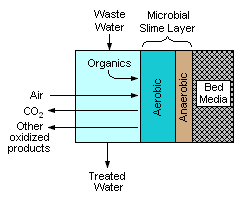Trickling filter
Trickling Filter[edit]
A trickling filter is a type of wastewater treatment system that uses a bed of media to remove organic matter from sewage. The media, often made of rocks, gravel, or specially designed plastic shapes, provides a surface for microorganisms to grow and form a biofilm. As wastewater is distributed over the media, the microorganisms break down the organic pollutants.

History[edit]
The concept of trickling filters dates back to the late 19th century. They were first developed in England and Germany as a method to treat sewage by allowing it to trickle over a bed of stones. The process was found to be effective in reducing biochemical oxygen demand (BOD) and suspended solids in wastewater.
Design and Operation[edit]
Trickling filters consist of a bed of media over which wastewater is distributed. The media can be made of various materials, including rocks, gravel, or plastic. The choice of media affects the efficiency and cost of the system.

Wastewater is distributed over the media using a rotating arm or fixed nozzles. As the water trickles down, it comes into contact with the biofilm on the media. The microorganisms in the biofilm consume the organic matter, converting it into carbon dioxide, water, and biomass.
Advantages and Disadvantages[edit]
Trickling filters are known for their simplicity and low operational costs. They do not require complex machinery and can operate with minimal energy input. However, they can be less effective in cold climates and may require large land areas.
Applications[edit]
Trickling filters are used in various settings, from small municipal wastewater treatment plants to large industrial facilities. They are particularly useful in areas where land is available and energy costs are a concern.

Maintenance[edit]
Regular maintenance of trickling filters involves cleaning the distribution system and monitoring the growth of the biofilm. Excessive growth can lead to clogging, while insufficient growth can reduce treatment efficiency.
Related Pages[edit]
References[edit]
- Metcalf & Eddy, Inc. (2003). Wastewater Engineering: Treatment and Reuse. McGraw-Hill.
- Tchobanoglous, G., Burton, F. L., & Stensel, H. D. (2003). Wastewater Engineering: Treatment and Reuse. McGraw-Hill.

-
Benfleet Sewage Treatment Plant Filter Bed
-
Diagram of a Trickle Filter
-
Cross-section of a Trickle Filter
-
Collapsed Trickling Filter at the WWTP in Norton
Ad. Transform your life with W8MD's Budget GLP-1 injections from $75


W8MD offers a medical weight loss program to lose weight in Philadelphia. Our physician-supervised medical weight loss provides:
- Weight loss injections in NYC (generic and brand names):
- Zepbound / Mounjaro, Wegovy / Ozempic, Saxenda
- Most insurances accepted or discounted self-pay rates. We will obtain insurance prior authorizations if needed.
- Generic GLP1 weight loss injections from $75 for the starting dose.
- Also offer prescription weight loss medications including Phentermine, Qsymia, Diethylpropion, Contrave etc.
NYC weight loss doctor appointmentsNYC weight loss doctor appointments
Start your NYC weight loss journey today at our NYC medical weight loss and Philadelphia medical weight loss clinics.
- Call 718-946-5500 to lose weight in NYC or for medical weight loss in Philadelphia 215-676-2334.
- Tags:NYC medical weight loss, Philadelphia lose weight Zepbound NYC, Budget GLP1 weight loss injections, Wegovy Philadelphia, Wegovy NYC, Philadelphia medical weight loss, Brookly weight loss and Wegovy NYC
|
WikiMD's Wellness Encyclopedia |
| Let Food Be Thy Medicine Medicine Thy Food - Hippocrates |
Medical Disclaimer: WikiMD is not a substitute for professional medical advice. The information on WikiMD is provided as an information resource only, may be incorrect, outdated or misleading, and is not to be used or relied on for any diagnostic or treatment purposes. Please consult your health care provider before making any healthcare decisions or for guidance about a specific medical condition. WikiMD expressly disclaims responsibility, and shall have no liability, for any damages, loss, injury, or liability whatsoever suffered as a result of your reliance on the information contained in this site. By visiting this site you agree to the foregoing terms and conditions, which may from time to time be changed or supplemented by WikiMD. If you do not agree to the foregoing terms and conditions, you should not enter or use this site. See full disclaimer.
Credits:Most images are courtesy of Wikimedia commons, and templates, categories Wikipedia, licensed under CC BY SA or similar.
Translate this page: - East Asian
中文,
日本,
한국어,
South Asian
हिन्दी,
தமிழ்,
తెలుగు,
Urdu,
ಕನ್ನಡ,
Southeast Asian
Indonesian,
Vietnamese,
Thai,
မြန်မာဘာသာ,
বাংলা
European
español,
Deutsch,
français,
Greek,
português do Brasil,
polski,
română,
русский,
Nederlands,
norsk,
svenska,
suomi,
Italian
Middle Eastern & African
عربى,
Turkish,
Persian,
Hebrew,
Afrikaans,
isiZulu,
Kiswahili,
Other
Bulgarian,
Hungarian,
Czech,
Swedish,
മലയാളം,
मराठी,
ਪੰਜਾਬੀ,
ગુજરાતી,
Portuguese,
Ukrainian



